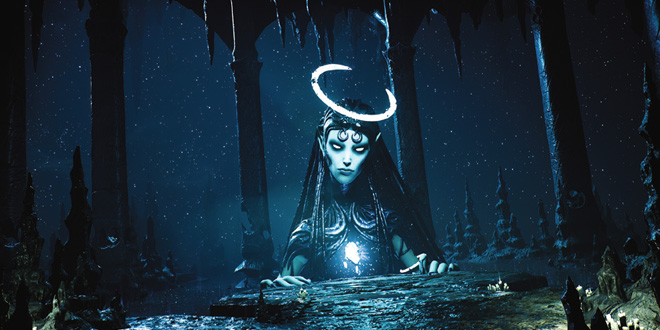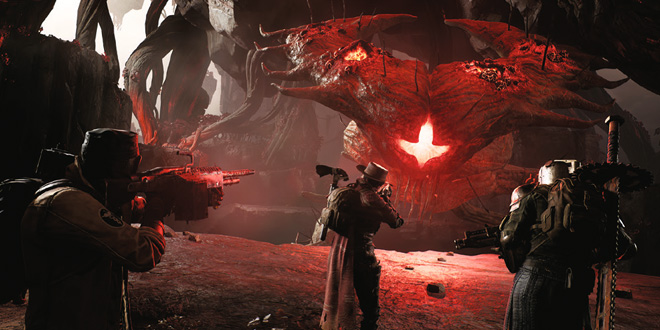 David Adams, Remnant II game director and president of Gunfire Games, tells Vince Pavey about the work that went into developing the sequel to Remnant: From the Ashes as the pair avoid catching Root Rot.
David Adams, Remnant II game director and president of Gunfire Games, tells Vince Pavey about the work that went into developing the sequel to Remnant: From the Ashes as the pair avoid catching Root Rot.
Remnant: From the Ashes first released back in the latter half of 2019, and was the first big console game launch from Gunfire Games. A remaster of Vigil Games’s Darksiders II aside, the Texas-based studio had mostly developed software for the VR gaming market, so its flashy, intense and atmospheric brand of ‘Dark Souls with guns’ arrived somewhat as a surprise for most.
Many a developer could tell you that Souls-likes are a tough nut to crack, but here at MCV, we would tell you that Gunfire was one of the first studios to get it right. The team found strength in doing something different, and rather than going for an ‘I can’t believe it’s not Dark Souls’-style clone, instead transposed the bonfires, equipment, character building and exploration staples of the popular action RPG sub-genre into something a little bit closer to a Gears of War; complete with three-player shooter co-op.
It was a mash-up that could’ve been a risky one in the wrong hands, but through deft and careful execution, Remnant: From the Ashes was ultimately a blast to play through that was positively received despite the occasional rough ‘first go at it’ edges that players would sometimes run into.
From the Ashes sold over three million copies during its first two years and became something of a cult hit, especially after it made its way to Xbox Game Pass just before the start of the current Xbox Series X/S and PlayStation 5 generation.

FRANCHISE ROOTS
Taking place on a ruined Earth that has been overtaken by an interdimensional evil called the Root, the first Remnant invited parties of custom player characters to explore the multiverse, make key decisions that would affect entire realms, and take on foes of many shapes and sizes. While the Root was ultimately defeated at the end of the game (we’re not considering this a spoiler, this is how stories work) — there was nothing to say that it couldn’t come back and cause more trouble that would instigate more adventures.
With the makings of a franchise on Gunfire’s hands, a sequel to the game for Xbox X/S and PS5 seemed inevitable — and then it was. Remnant 2 went into development alongside a non-VR version of the 2016 VR game Chronos — rebranded as Chronos: Before the Ashes, to better advertise its Remnant story links to potential buyers. The question was, what game design changes could players expect for the sequel, and where would the team find inspiration?
“There was a lot of stuff we did in the sequel that was stuff we wanted to do in the first game,” says Gunfire president David Adams. “But Remnant overall was influenced by several games. Left 4 Dead, Terraria — surprisingly, I know — as well as Resident Evil 4 and the Souls games.
“I think as game developers we are influenced by many different things, including TV, Movies, books and other sorts of media. Different worlds within Remnant II draw influences from different things. [The world of] Losomn was influenced by an old game we had worked on that never shipped that took place in the 1880s. N’Erud has a little bit of Dune in there, as well as a little bit of Prometheus or Aliens. Yaesha – well, it’s been a while since we dreamed up Yaesha, so I’m having trouble remembering the influences.”
With a sequel, it’s always a question of ‘How much follow-on do you include?’ or ‘How much of a sequel should the sequel be?’, to which there is rarely a right answer. Some studio teams will throw the entire thing out and start afresh with similar themes, while others will continue stories into and beyond their ‘natural’ end points, through whatever narrative means they can utilise.
The Remnant story started out about the multiverse. This meant that it was possible for the Gunfire team to do a mostly-new adventure that also continued with plot threads and a revisited couple of familiar locales from the studio’s last two games, without it feeling contrived.
“We made a VR game before Remnant called Chronos, which was eventually ported to other platforms,” explains Adams. “Yaesha was in that game, as well as in Remnant: From the Ashes, so we thought it would be cool to see the full story arc for that world. In Chronos (spoiler alert) the protagonist is the cause of Yaesha being invaded by the Root, so by Remnant II, you get to see the full effect of those actions. “The labyrinth came back because it’s an essential part of the Remnant games’ lore, but beyond that, we wanted to create new worlds for players to explore.”

INSTANT REPLAY
One of the elements the team wanted to make sure of was that Remnant 2 was more replayable than its predecessor, which wasn’t noted for being a game many players returned to after their first time seeing the credits. As such, the studio focused on making the worlds of Remnant II more interesting to visit and adventure through. As a result, adventures feel a little more magical – especially at first, if you know someone else is playing at the same time. The game’s emphasis on replayability is evident early on with its multiple starting areas and realm instances – built using procedural generation to change things up on a player-by-game basis. Worlds even include secrets that not everyone will see, as they trigger randomly – another boon for replayability.
“In the first Remnant, even though the dungeons and bosses were randomized, the overall storyline for each biome was the same each time. In Remnant II, we randomized the storyline in each world, as well as added quite a few more side quests, injectables and stuff like that,” Adams says. “Players should be able to play the game multiple times and see a completely different set of quests and storylines.
“We did it to really drive home the fact that your experience was unique from other players,” he continues. “You might have two friends start the game at the same time, and one of them is playing in a jungle, and the other in a sci-fi wasteland.”

THE CORE LOOP
Of course, replayability would mean nothing if the game itself wasn’t fun to play. Thankfully most of the Remnant II’s formula had already been worked out during the development of its predecessor. Mostly, that core comes down to fostering a sense of meaningful exploration. “We wanted the core loop to be compelling,” explains Adams. “Go in, explore a new world, find some items, play with your build – maybe find a cool secret – then kill a boss. We also try to make the individual side quests and story elements unique, with some cool ‘aha’ moments so players do something unexpected or see something interesting. Hopefully giving them that sense that they should keep exploring because they aren’t sure what they will find.”
Another conscious and deliberate choice when it came to changes to the core design of the game was to redesign the game’s up-close weapons and their melee attacks. These changes, in our experience, made bashing stuff with your weapon less useful than last time, and put more emphasis on the fact the game is supposed to be played like a co-op shooter.
“Melee has always been a means to conserve ammo or provide you with a way of attacking when you are out of ammo,” says Adams. “I do think the melee combat is much better in Remnant II compared to Remnant: From the Ashes, but for sure, shooting is meant to be the primary way to fight.”
Like with any challenging game, the boss battles in particular can be a test of both player skill and the player’s patience, often simultaneously. As such, conflicts can be quite difficult in Remnant II, and making sure that things were fair came down to extensive playtesting, including with players that weren’t as familiar with the game or its genre as the development team was.
“Honestly? We just play the bosses a bunch of times, and continuously tune them over time,” says Adams. “We want them to be challenging, but we also don’t want a player to feel like it’s hopeless and they will never win. We also have testers we use to test the bosses, and we ran several friends-and-family alpha tests during development. “Balancing the game for such a wide variety of player skills is a challenge, but we do our best to strike a good balance.”

NO REGRETS, WHAT’S NEXT
When it comes to Remnant II’s overall production, Adams actually doesn’t have many, if any, development regrets. As he tells it, the studio effectively managed its time and budget, and outside of the usual quirks and bugs that get ironed out as a project makes its way from prototype to final product, things went as well as could be expected. “For Remnant II, I’m happy with what we did,” says Adams.
“We managed to do pretty much everything we set out to do when we started the project, which is rare. Obviously, if I could go back in time, I’d make sure any major issues, bugs, performance issues were nailed down – but development is a game of finite resources, and sometimes you do the best with what you have available.” Following a positive response from both video game critics and the wider audience of players — only some of which were eagerly anticipating their next adventure through the multiverse, and others coming to check out the series for the first time — the foreseeable future for the Gunfire Games will be more work on Remnant II.
“The reaction has been great,” says Adams. “You can spend three or four years working on a project, so there is always some trepidation when you release it to the world. You do your best to fix all the bugs, tune the difficulty — but as soon as the game is out in the wild, all bets are off. I’m just glad we made a game people enjoy. Hopefully we can add to that over time.
As for what form Remnant 2’s future will take, Adams doesn’t elaborate — but we’re sure there are plenty more portals to worlds out in the desolate and constantly shifting Labyrinth, and we look forward to embarking on whatever adventures the studio takes us on next.

 MCV/DEVELOP News, events, research and jobs from the games industry
MCV/DEVELOP News, events, research and jobs from the games industry




